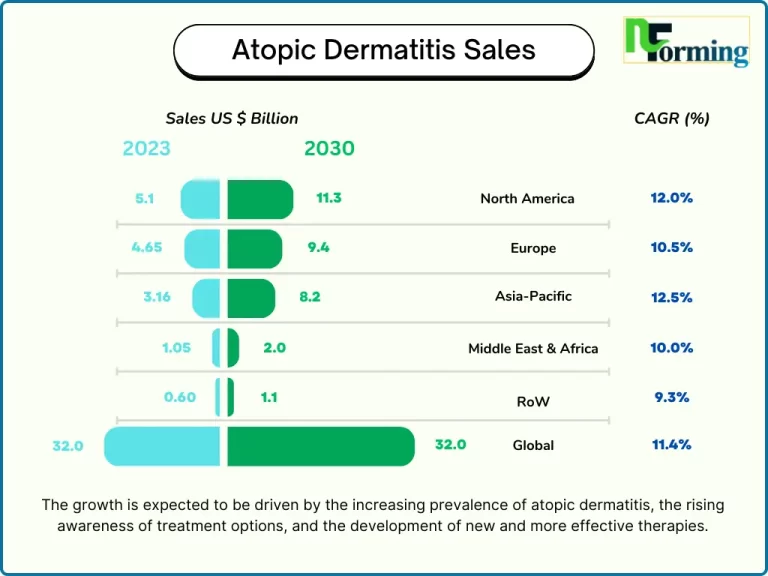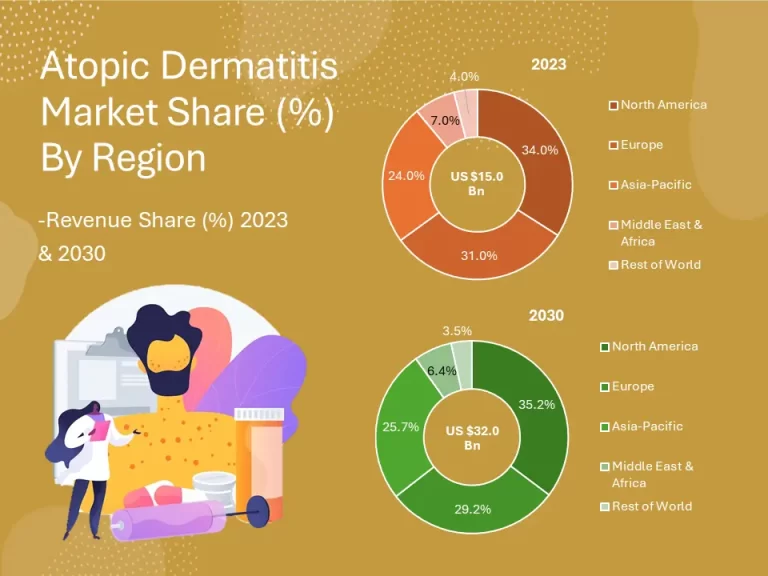Atopic Dermatitis Market Regional Analysis Summary
The global atopic dermatitis market is projected to experience significant growth, with an estimated increase from US $15.0 billion in 2023 to US $32.0 billion in 2030, representing a compound annual growth rate of 11.4%. The projected growth in this field can be attributed to several factors, such as the growing incidence of atopic dermatitis, the heightened awareness of available treatment options, and the ongoing advancements in therapies that are proving to be more effective.
Atopic Dermatitis Market by Regional
Projected sales figures for the Atopic Dermatitis market in different regions are available for the years 2023 and 2030, along with the Compound Annual Growth Rate (CAGR) for each region. Here is a detailed analysis of the projected expansion in various regions:

North America Atopic Dermatitis Market
Throughout the forecast period, North America is projected to maintain its position as the largest atopic dermatitis market, with a strong compound annual growth rate of 12.0%. The anticipated growth in this field can be attributed to several factors, such as the widespread occurrence of atopic dermatitis in the area, the advanced healthcare system, and the rising acceptance of novel treatment methods.
Asia-Pacific Atopic Dermatitis Market
The Asia-Pacific region is projected to experience significant growth in the atopic dermatitis market, with a compound annual growth rate (CAGR) of 12.5%. The projected growth in this sector can be attributed to several factors. These include the rising incidence of atopic dermatitis in the region, the improving financial capabilities of consumers, and the increasing knowledge about available treatment choices.
Europe Atopic Dermatitis Market
Europe is projected to experience a significant growth rate of 10.5%. The anticipated growth in this sector can be attributed to several factors, such as the widespread occurrence of atopic dermatitis in the area, the advanced healthcare system, and the rising acceptance of cutting-edge treatments.
Middle East and Africa Atopic Dermatitis Market
The Middle East and Africa region is projected to experience a significant growth rate of 10.0%. The region is poised for significant growth, thanks to several key factors. These include the growing incidence of atopic dermatitis, the rising purchasing power of consumers, and the ongoing improvements in healthcare facilities.
The Rest of the World is projected to experience a significant growth rate of 9.3%.
Atopic Dermatitis Market Customer Behavior Overview by Region
North America
It is anticipated that customers in North America will become more knowledgeable about treatment options for atopic dermatitis and will be willing to invest in new and groundbreaking therapies. Several factors contribute to this phenomenon, such as the widespread occurrence of atopic dermatitis in the area, the robust healthcare system, and the rising purchasing power of consumers. Consequently, there is a market need for various products, including:
- Prescription topical corticosteroids are frequently prescribed for atopic dermatitis, as they are highly recommended by medical professionals. These products function by effectively reducing both inflammation and itching.
- Calcineurin inhibitors are topical medications that function by suppressing the immune system. These are commonly prescribed for individuals with moderate to severe atopic dermatitis.
- Dupilumab is a biologic therapy that is administered through subcutaneous injections. This treatment is effective for managing moderate to severe atopic dermatitis in adults and children aged 12 and above.
Asia-Pacific (APAC)
Customers in the Asia-Pacific region are projected to become more knowledgeable about treatment options for atopic dermatitis. However, they may display a higher level of price sensitivity compared to customers in North America. This can be attributed to various factors, such as the increasing disposable incomes of consumers in the region, as well as the ongoing development of healthcare infrastructure in certain countries. Consequently, there is a need for a combination of prescription and over-the-counter (OTC) medications, including:
- Topical corticosteroids are expected to continue being the preferred choice for treating atopic dermatitis in the Asia-Pacific region. This is because of their effectiveness and affordable price.
- Emollients are moisturizers that work to hydrate the skin and enhance its barrier function. They play a crucial role in the treatment regimen for atopic dermatitis.
- Over-the-counter anti-itching medications can provide relief from the itching caused by atopic dermatitis.
Europe
Customers in Europe are anticipated to exhibit similar characteristics to customers in North America regarding their knowledge of treatment options and their willingness to invest in novel and groundbreaking therapies. Several factors contribute to this phenomenon, such as the widespread occurrence of atopic dermatitis in the area, the advanced healthcare system, and comparable levels of disposable income. Due to market trends, there is a growing need for comparable products in North America, including:
- Prescription topical corticosteroids and calcineurin inhibitors are commonly used in dermatology.
- Biologic therapies such as dupilumab are gaining attention, particularly with the emergence of biosimilars. These biosimilars, although not exact replicas, have the potential to provide a more affordable alternative.
Middle East and Africa (MEA)
It is anticipated that customers in the MEA region will become increasingly aware of the various treatment options available for atopic dermatitis. However, their access to these treatments may be restricted due to challenges such as underdeveloped healthcare infrastructure and lower disposable incomes. There is potential for improvement in the future, but it is crucial to address the issue of affordable treatment options. Consequently, there is a need for:
- Over-the-counter medications like emollients and OTC anti-itching medications.
- Efforts by the government and educational institutions to enhance understanding of atopic dermatitis and enhance the availability of treatment options.
Rest of the World
The category labeled as “Rest of the World” encompasses a wide range of countries, each with its own unique customer behavior patterns. However, there are some general trends that can be anticipated:
- Enhancing knowledge about treatment options for atopic dermatitis.
- In certain countries, the healthcare infrastructure may not be as developed, resulting in limited access to advanced treatment options.
- An emphasis on cost-effective options for a combination of prescribed and over-the-counter medications.
Atopic Dermatitis Market Share by Region

In North America, despite having the largest market share (estimated at 34.0% in 2023), there is expected to be only moderate growth. This indicates a possible steady growth in market share when compared to other regions.
The market share in Europe is expected to see a gradual increase in overall sales for atopic dermatitis. However, the overall market share of Europe in the global atopic dermatitis market is expected to decline due to other fast-growing regions. The European region is estimated to be 29.2% of the total atopic dermatitis market in 2030.
The Asia-Pacific region is poised to experience a substantial boost in market share, thanks to its impressive growth rate. Although the current atopic dermatitis market share is lower in comparison to North America, Asia-Pacific is expected to gain a larger portion 25.7% of the global atopic dermatitis market in 2030.
Overall atopic dermatitis sales in the MEA region is expected to experience a more gradual growth due to its. There is a possibility that the market share could remain stagnant or experience only a slight decrease from 7.0% in 2023 to 6.4% due to a lower growth rate in comparison to other regions.
The rest of the World’s Market share growth in this category is expected to be the slowest. The market share may experience little to no growth.
Atopic Dermatitis Market Product Recommendations by Region
Based on the customer behavior analysis, here are some product recommendations by region:
- North America & Europe: Focus on innovative therapies like biologics and combination products that address multiple aspects of atopic dermatitis.
- Asia-Pacific: Offer a mix of prescription and OTC medications, with a focus on cost-effectiveness. Emphasise emollients and develop culturally appropriate formulations.
- MEA: Develop affordable treatment options, such as generic versions of established medications. Partner with governments and healthcare organisations to raise awareness and improve access to treatment.
- Rest of the World: Tailor product offerings to the specific needs of each country, considering factors such as healthcare infrastructure, disposable income, and cultural preferences.
Atopic Dermatitis Market Sales Channels
Here are some suggested sales channels to capture a larger market share in each region, taking into account the expected changes:
Regions of North America and Europe:
- Emphasize the importance of maintaining strong direct sales by prioritizing relationships with dermatologists and pediatricians, given the well-established healthcare systems.
- Enhance online presence: Provide valuable educational resources and utilize e-commerce platforms to connect with a wider range of individuals.
- Enhance collaborations with speciality pharmacies: Streamline the distribution process for prescription medications to maximize efficiency.
Asia-Pacific
- Develop and execute a comprehensive approach to reach customers through multiple channels. Utilize a combination of online and offline channels, such as drugstores, pharmacies, and online platforms, to effectively reach customers with different levels of internet access.
- Emphasize the importance of forming strategic alliances with drugstores and pharmacies to ensure widespread availability of over-the-counter medications and emollients.
- Discover telemedicine platforms: Provide remote consultations in regions with emerging healthcare systems.
MEA
- Establish alliances with governmental entities: Work together to increase public knowledge and enhance availability of cost-effective treatment choices.
- Make use of mHealth platforms: Provide patients with education and the option for remote consultations in areas where mobile phone usage is prevalent.
- Collaborate with non-governmental organizations (NGOs) to ensure that treatment is accessible to communities that have been overlooked, while also enhancing your brand’s reputation.
Rest of the World
- Create a customized strategy: Adjust sales channels for different countries, taking into account factors such as internet usage, available income, and healthcare facilities.
- Explore local partnerships: Work together with healthcare providers and distributors in the area to better understand and navigate the unique regulations and cultural aspects.
Conclusion
The global atopic dermatitis market is poised for substantial growth in the coming years. This growth can be attributed to several factors, such as the growing number of people affected by atopic dermatitis, the increasing awareness about available treatment options, and the continuous development of innovative and improved therapies. On the other hand, customer behavior may differ depending on the region. Companies that have the ability to customize their products and marketing approaches to meet the unique demands of different regions will have a competitive advantage in this expanding market.
Additional Considerations
- Cultural Nuances: Adapt marketing messages and product formulations to resonate with local preferences in each region.
- Digital Marketing: Implement SEO and social media marketing strategies for regions with high internet penetration.
- Regulatory Landscape: Ensure compliance with all local regulations regarding pharmaceutical sales and marketing.
Full Report Available starting from $199. Contact Us read full report on this market or email us for the free subscription on nfo@nforming.com.

